The GeForce GTX 660 Ti Review, Feat. EVGA, Zotac, and Gigabyte
by Ryan Smith on August 16, 2012 9:00 AM ESTPower, Temperature, & Noise
As always, we’re wrapping up our look at a video card’s stock performance with a look at power, temperature, and noise. Like we discussed in the introduction, while the official TDP of the GTX 660 Ti is 150W – 20W lower than the GTX 670 – the power target difference is only 7W. So let’s see which is more accurate, and how that compares to AMD’s cards.
| GeForce GTX 660 Ti Voltages | ||||
| Zotac GTX 660 Ti Boost Load | EVGA GTX 660 Ti Boost Load | Gigabyte GTX 660 Ti Boost Load | ||
| 1.175v | 1.162v | 1.175v | ||
Stopping to take a quick look at voltages, there aren’t any big surprises here. NVIDIA would need to maintain the same voltages as the GTX 670 because of the identical clocks and SMX count, and that’s exactly what has happened. In fact all single-GPU GK104 cards are topping out at 1.175v, NVIDIA’s defined limit for these cards. Even custom cards like the Gigabyte still only get to push 1.175v.
Up next, before we jump into our graphs let’s take a look at the average core clockspeed during our benchmarks. Because of GPU boost the boost clock alone doesn’t give us the whole picture – particularly when also taking a look at factory overclocked cards – we’ve recorded the clockspeed of our video cards during each of our benchmarks when running them at 2560x1600 and computed the average clockspeed over the duration of the benchmark. Unfortunately we then deleted the results for the factory overclocked cards, so we only have the “reference” card. Sorry about that guys.
| GeForce GTX 600 Series Average Clockspeeds | |||||||
| GTX 670 | GTX 660 Ti | Zotac GTX 660 Ti | EVGA GTX 660 Ti | Gigabyte GTX 660 Ti | |||
| Max Boost Clock | 1084MHz | 1058MHz | 1175MHz | 1150MHz | 1228MHz | ||
| Crysis | 1057MHz | 1058MHz | N/A | ||||
| Metro | 1042MHz | 1048MHz | |||||
| DiRT 3 | 1037MHz | 1058MHz | |||||
| Shogun 2 | 1064MHz | 1035MHz | |||||
| Batman | 1042MHz | 1051MHz | |||||
| Portal 2 | 988MHz | 1041MHz | |||||
| Battlefield 3 | 1055MHz | 1054MHz | |||||
| Skyrim | 1084MHz | 1045MHz | |||||
| Civilization V | 1038MHz | 1045MHz | |||||
The average clockspeeds on our “reference” GTX 660 Ti don’t end up fluctuating all that much. With a max boost of 1058 the card actually gets to run at its top bin in a few of our tests, and it isn’t too far off in the rest. The lowest is 1035 for Shogun 2, and that’s only an average difference of 22MHz. The GTX 670 on the other hand had a wider range; a boon in some games and a bane in others. If nothing else, it means that despite the identical base and boost clocks, our cards aren’t purely identical at all times thanks to the impact of GPU boost pulling back whenever we reach our power target.
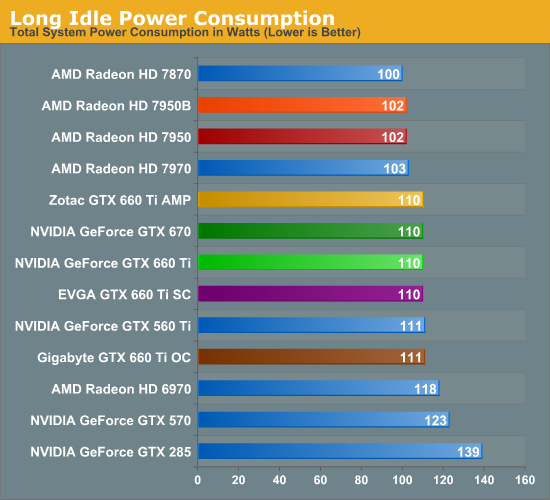
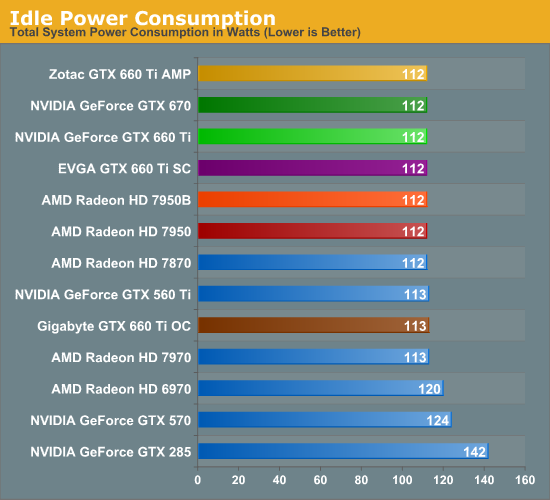
There are no great surprises with idle power consumption. Given the immense similarity between the GTX 670 and GTX 660 Ti, they end up drawing the same amount of power both during idle and long idle. This does leave AMD with an 8W-10W lead at the wall in this test though.
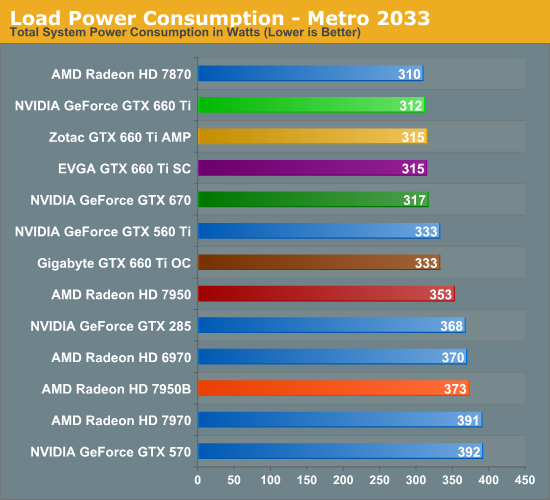
Moving on to our load power tests we start with Metro: 2033. As we mentioned previously the GTX 660 Ti and GTX 670 have very similar power targets, and this benchmark confirms that. Power consumption for the GTX 660 Ti is virtually identical to the Radeon HD 7870, an interesting matchup given the fact that this is the first time NVIDIA has had to compete with Pitcairn. Pitcairn’s weaker compute performance means it starts off in a better position, but it looks like even with a salvaged GK104 NVIDIA can still compete with it. NVIDIA drove efficiency hard this generation; to compete with a smaller chip like that is certainly a testament to that efficiency.
As for the inevitable 7950 comparison, it’s no contest. The GTX 670 was already doing well here and the GTX 660 Ti doesn’t change that. Tahiti just can’t match GK104’s gaming efficiency, which is why AMD has had to push performance over power with the new 7950B.
Meanwhile it’s fascinating to see that the GTX 660 Ti has lower power consumption than the GTX 560 Ti, even though the latter has the advantage of lower CPU power consumption due to its much lower performance in Metro. Or better yet, just compare the GTX 660 Ti to the outgoing GTX 570.
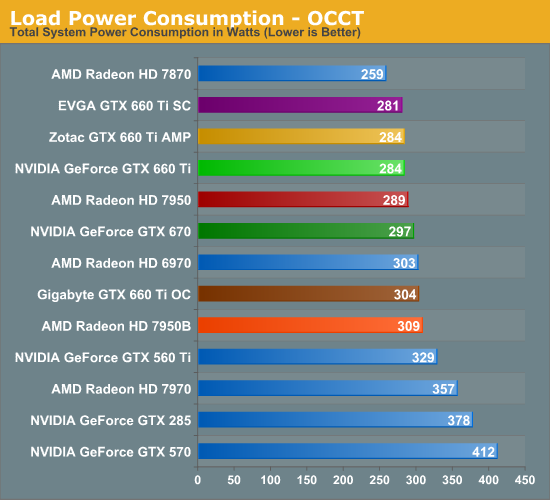
For AMD/NVIDIA comparisons we have a bit less faith in our OCCT results than we do our Metro results right now, as NVIDIA and AMD seem to clamp their power consumption differently. NVIDIA’s power consumption clamp through GPU Boost is far softer than AMD’s PowerTune. As a result the 7870 consumes 25W less than the GTX 660 Ti here, which even with AMD’s very conservative PowerTune rating seems like quite the gap. Metro seems to be much more applicable here, at least when you’re dealing with cards that have similar framerates.
In any case, compared to NVIDIA’s lineup this is another good showing for the GTX 660 Ti. Power consumption at the wall is 45W below the GTX 560 Ti, a large difference thanks to the latter’s lack of power throttling technology.
As for our factory overclocked cards, these results are consistent with our expectations. Among the Zotac and EVGA cards there’s a few watts of flutter at best, seeing as how they have the same power target of 134W. Meanwhile the Sapphire card with its higher power target is 20W greater at the wall, which indicates that our estimated power target of 141W for that card is a bit too low. However this also means that those times where the Gigabyte card was winning, it was also drawing around 20W more than its competition, which is a tradeoff in and of itself.
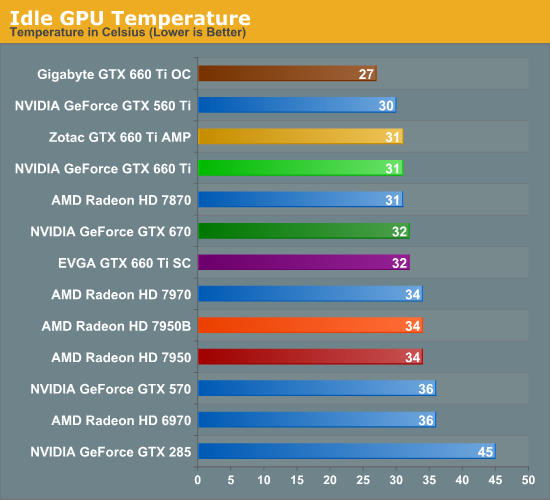
Moving on to temperatures, at 31C the GTX 660 Ti is once more where we’d expect it to be given the similarities to the GTX 670. Open air coolers tend to do a bit better here than blowers though, so the fact that it’s only 1C cooler than the blower-type GTX 670 is likely a reflection on Zotac’s cooler.
Speaking of factory overclocked video cards, one card stands out above the rest: the Gigabyte GTX 660 Ti. That oversized cooler does its job and does it well, keeping the GPU down to barely above room temperature.
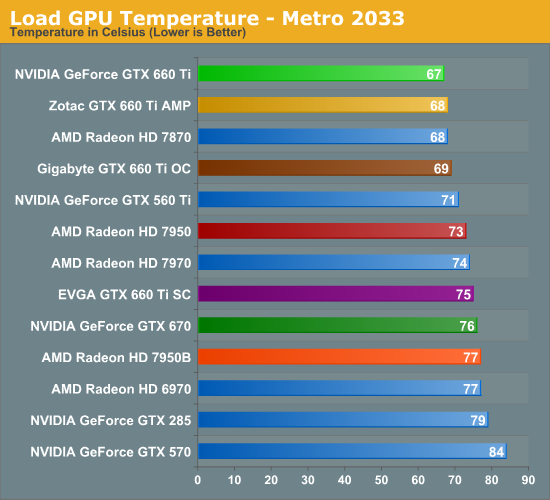
Considering that most of our high-end cards are blowers while our “reference” GTX 660 Ti is an open air cooler, temperature benchmarks are the GTX 660 Ti’s to win, and that’s precisely what’s going on. 67C is nice and cool too, which means that the open air coolers should fare well even in poorly ventilated cases.
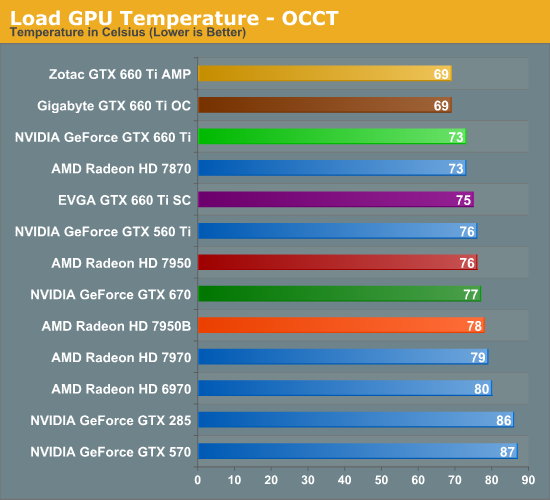
As usual we see a rise in temperatures when switching from Metro to OCCT, but at 73C the GTX 660 Ti is still the coolest reference (or semi-reference) card on the board. To be honest we had expected that it would beat the 7870, but as far as blowers go the 7870’s is quite good.
Moving on to our factory overclocked cards, we’re seeing the usual divisions between open air coolers and blowers. The blower-based EVGA card performs almost identically to the GTX 670, which makes sense given the similarities between the cards. Meanwhile the open air Zotac and Gigabyte cards are neck-and-neck here, indicating that both cards are shooting for roughly the same temperatures, keeping themselves below 70C. Though it’s somewhat weird to see the factory overclocked Zotac card end up being cooler than its reference-clocked self; this appears to be a product of where the fan curve is being hit.
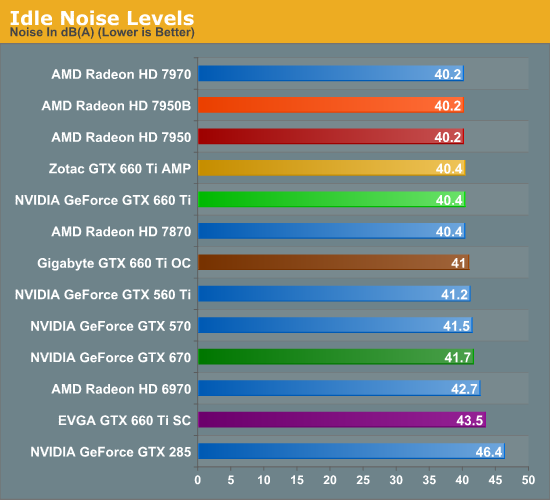
Last but not least we have our look at noise, where we’ll hopefully be able to fully shake out our factory overclocked cards.
Right off the bat we see the blower-based EVGA struggle, which was unexpected. It’s basically the same cooler as the GTX 670, so it should do better. Then again the EVGA GTX 670 SC had the same exact problem.
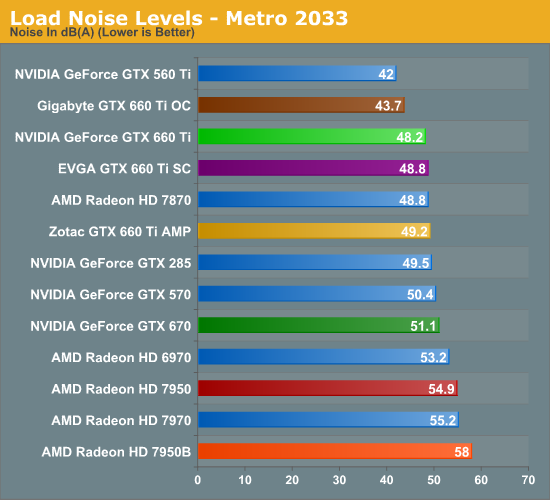
As for Metro, the GTX 660 Ti once again looks good. 48.2 isn’t the best for an open air cooler, but it’s a hair quieter than the 7870 and notably quieter than the GTX 670. The only unfortunate part about these results is that it just can’t beat the GTX 560 Ti; in fact nothing can. For its power consumption the GTX 560 Ti was an almost unreal card, but it’s still a shame the GTX 660 Ti can’t be equally unreal.
Moving on to our factory overclocked cards however, the Gigabyte GTX 660 Ti OC gets very close thanks to its very large cooler. 43.7dB technically isn’t silent, but it just as well should be. To offer the performance of a GTX 660 Ti (and then some) in such a package is quite the accomplishment.
As for Zotac and EVGA, there’s nothing bad about either of them but there’s also nothing great. EVGA’s card is about average for a blower, while Zotac’s card seems to be suffering from its size. It’s a relatively tiny card with a relatively tiny cooler, and this has it working harder to hit its temperature targets.
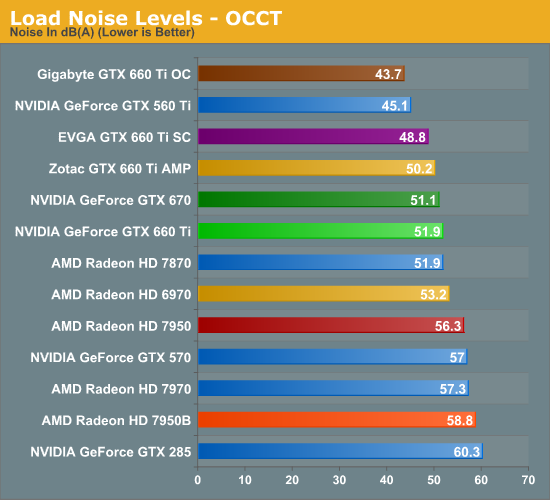
Finally we have noise testing with OCCT. Our “reference” GTX 660 Ti actually fares a bit worse than the GTX 670, which is unfortunate. So much of this test comes down to the cooler though that it’s almost impossible to predict how other cards will perform. At least it’s no worse than the 7870.
Meanwhile the Gigabyte GTX 660 Ti OC continues to impress. 43.7dB not only means that it didn’t get any louder switching from Metro to OCCT, but it has now bested the GTX 560 Ti thanks to the 560’s lack of power throttling technology. Make no mistake, 43.7dB for this kind of performance is very, very impressive.
As for EVGA and Zotac, it’s also a rehash of Metro. EVGA’s blower is actually over 1dB quieter than Zotac’s cooler, which is an unfortunate outcome for an open air cooler.
Wrapping things up, even without a true reference sample from NVIDIA it’s clear that the GTX 660 Ti has a lot of potential when it comes to power/temp/noise. Compared to other cards it’s roughly equivalent in power consumption and noise to the 7870, which for NVIDIA is an important distinction since it’s also notably faster than the 7870, so NVIDIA is on a better place on the power/performance curve. This goes for not only the 7870, but especially the 7950, where the GTX 660 Ti continues the tradition the GTX 670 already set, which will see the GTX 660 Ti being cooler, quieter, and less power hungry than AMD’s entry-level Tahiti part.
But it must be pointed out that the lack of a reference design for the GTX 660 Ti means buyers are also facing a lot of variability. Power consumption should be consistent between cards – which is to say a hair less than the GTX 670 – but temperature and especially noise will vary on a card by card basis. Potential buyers would best be served by checking out reviews ahead of time to separate the duds from the gems.










313 Comments
View All Comments
rarson - Friday, August 17, 2012 - link
I might have said that ten years ago, but when I read stuff like "the GTX 680 marginalized the Radeon HD 7970 virtually overnight," I wonder what kind of bizarro universe I've stumbled into.CeriseCogburn - Sunday, August 19, 2012 - link
That's the sales numbers referred to there rarson - maybe you should drop the problematic amnesia ( I know you can't since having no clue isn't amnesia), but as a reminder, amd's crap card was $579 bucks and beyond and nVidia dropped in 680 at $499 across the board...Amd was losing sales in rapid fashion, and the 680 was piling up so many backorders and pre-purchases that resellers were gbegging for relief, and a few reviewers were hoping something could be done to stem the immense backorders for the 680.
So:
" "the GTX 680 marginalized the Radeon HD 7970 virtually overnight,"
That's the real world, RECENT HISTORY, that real bizarro world you don't live in, don't notice, and most certainly, will likely have a very difficult time admitting exists.
Have a nice day.
Biorganic - Saturday, August 18, 2012 - link
Go look up Bias in a dictionary instead of flinging around insults like a child. When the adults converse amongst themselves they like to Add things to the actual conversation, not unnecessarily degrade people. Thanks! @$$-OJamahl - Thursday, August 16, 2012 - link
The point I was making was that Nvidia has seeded overclocked cards to the majority of the tech press, while you had a go at AMD for their 7950 boost.After all the arguments and nonsense over the 7950 boost, hardly anyone benchmarked it but still plenty went ahead and benched the overclocked cards sent by Nvidia. Two AMD partners have shown they are releasing the 7950 boost edition asap, prompting a withdrawal of the criticisms from another nvidia fansite, hardwarecanucks.com
So again I ask, AMD's credibility? The only credibility at stake is the reviewers who continually bend over to suit Nvidia. Nvidia has no credibility to lose.
silverblue - Friday, August 17, 2012 - link
I'm afraid I have to back you up on this one. NVIDIA released not one, not two but THREE GT 640s, and I think people have forgotten about that one. AMD have replaced the 7950 BIOS and as such have overclocked it to the performance level where it probably should've been to start with (the gap between 7950 and 7970 was always far more than the one between 7870 and 7950).Yes, AMD should've given it a new name - 7950 XT as I said somewhere recently - but it's not even two-thirds as bad as the GT 640 fiasco. At least this time, we're talking two models separated only by a BIOS change and the consequently higher power usage, not two separate GPU generations with vastly different clocks, shader counts, memory types and so on.
If I'm wrong, I'm wrong, however I don't understand how AMD's GPU division's credibility could be damaged by any of this. Feel free to educate me. :)
CeriseCogburn - Sunday, August 19, 2012 - link
For your education and edification: amd failed in their card release by clocking it too low because they had lost the power useage war(and they knew it), and charging way too much on release.They suck, and their cred is ZERO, because of this.
Now it not only harmed amd, it harmed all of us, and all their vender partners, we all got screwed and all lost money because of amd's greed and incompetence.
Now amd, in a desperate panic, and far too long after the immense and debilitating blunder, that also left all their shareholders angry (ahem), after dropping the prices in two or three steps and adding 3 games to try to quell the massive kicking their falling sales to nVidia injuries...
FINALLY pulled their head out of it's straight jacket, well, halfway out, and issued permission for a GE version.
Now, maybe all you amd fans have been doing much and very excessive lying on 78xx79xx OC capabilities, or amd is just dumb as rocks and quite literally dangerous to themselves, the markets, their partners, all of us.
I think it's a large heaping of BOTH.
So there we have it - amd cred is where amd fanboy cred is - at the bottom of the barrel of slime.
Galidou - Sunday, August 19, 2012 - link
Anyway, with you AMD fails, always failed and will continue to fail at everything... I don't know if you think people will read your posts like religious madmans and beleive it a 100%, you're making it so exagerated, that it's barely readable.The words nazi and such comes back so often when you go on the madman route, that it's a wonder if anyone gives you any credibility. A little sad because you have nice arguments, you just display them surrounded by so much hate, it's hard to give you any credit for them.
We do exagerate AMD's performance just for the sake of being fanboys, but not to the point of saying such debilitating stuff like you're so good at it. Not to the point of totally destroying Nvidia and saying it's worth NOTHING like you do for AMD. I may lean a little on AMD's side because for my money they gave me more performance from the radeon 4xxx to the 6xxx series. I won't forget my 8800gt either, that was a delight for the price too. But I can recon when a video card wins at EVERYTHING and is doing WONDERS and none is happening now, it's a mixed bag of feeling. between overclockability, optimization on certain games, etc...
When the 8800gt and radeon 4870 came out, there was nothing people could say, just nothing, for the price, they were wonders, trampling over anythingbefore and after but at the same time you said they were mistake because they were not greedy enough moves.
Wanna speak about greed, why is Nvidia so rich, you defend the most rich video card maker in history but you accuse the others of being greedy, society is built on greed, go blame others. Couldn't they sell their GPU at lower prices to kill AMD and be less greedy? No, if AMD die, you'll see greed and 800$ gpus, speak about greed.
CeriseCogburn - Thursday, August 23, 2012 - link
Didn't read your loon spiel, again, not even glossed, part of 1st sentence.I won't tell you to shut up or change what you say, because I'm not a crybaby like you.
AMD sucks, they need help, and they only seem to fire more people.
Galidou - Thursday, August 23, 2012 - link
To date your best argument that repeats itself is ''AMD sucks'' which is something you learn to say when you're a kid. You're not a crybaby ohhh that's new, you keep crying more than everyone else I've seen, TheJian might be a fanboy but you're more related to the fanatic side of the thing.Still, they are the most rich video maker in history, but they still try to manipulate opinions like every company does. Why? if their product is so good and perfect, why do they have to manipulate? I hear you already saying something like: It's because that AMD suck, they suck so much that Nvidia has to make em suck even more by manipulating the stoopid reviewers because the world is against Nvidia and I'm their Crusader.... good job.
CeriseCogburn - Thursday, August 23, 2012 - link
Yes, I've never crapload of facts nor a single argument of note, and your head is a bursting purple strawberry too mr whiner.